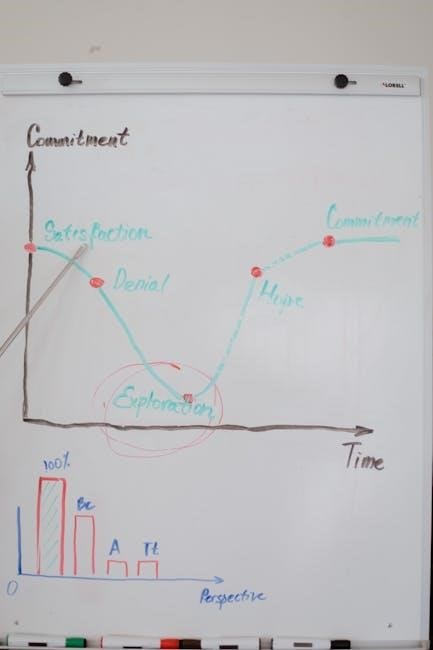The 100 Concepts Anatomy PDF is a concise guide covering essential anatomical principles, designed for medical students to master key topics efficiently for exams like USMLE Step 1.
What is the 100 Concepts Anatomy PDF?
The 100 Concepts Anatomy PDF is a concise and organized resource designed to help medical students master essential anatomical principles. It covers 100 key concepts, each presented in a clear and straightforward manner, making it easy to digest. The document focuses on foundational topics such as the skeletal system, muscular fundamentals, nervous system overviews, and internal organs, while also addressing clinical implications and common pathologies. Created with the goal of enhancing understanding and application, it emphasizes active learning over rote memorization. The PDF is complemented by visual aids, including detailed diagrams contributed by experts like Mrs. Jasmine Naik and Mrs. Zeenat Shaikh, who dedicated significant effort to ensure accuracy and clarity. Additionally, an accompanying Anki deck is available for active recall and efficient revision, making it a valuable tool for exam preparation and clinical practice.
Purpose and Scope of the Document
The 100 Concepts Anatomy PDF is specifically designed as a study guide for medical students, particularly those preparing for high-stakes exams like the USMLE Step 1. Its primary purpose is to provide a focused and efficient way to master essential anatomical concepts, ensuring a strong foundation for both exams and clinical practice. The document covers a wide range of topics, from skeletal and muscular systems to nervous system overviews and internal organ functions, with a strong emphasis on clinical relevance. It is structured to be concise, allowing students to quickly grasp high-yield information without overwhelming detail. The scope includes anatomical structures, common pathologies, and their clinical implications, making it a comprehensive yet manageable resource for learners. Supplementary materials, such as Anki decks and video resources, further enhance its utility, catering to diverse learning styles and preferences. This document serves as a bridge between basic anatomical knowledge and practical application, making it an indispensable tool for medical education.

Importance of the 100 Concepts in Anatomy
The 100 Concepts Anatomy PDF provides a concise guide to essential anatomical principles, emphasizing clinical relevance and exam preparation, making it vital for medical students and professionals alike.
Why These Concepts Are Crucial for Medical Students
The 100 Concepts Anatomy PDF is tailored to meet the needs of medical students, providing a focused approach to mastering high-yield anatomical topics essential for exams like USMLE Step 1. These concepts are carefully selected to cover foundational knowledge, ensuring a strong understanding of the human body’s structure and function. By emphasizing clinical relevance, the guide helps students connect anatomy to real-world patient care, enhancing diagnostic and treatment skills. The concise format allows for efficient study, making it ideal for students with demanding schedules. Additionally, the integration of active recall methods, such as Anki decks, reinforces long-term retention. This resource is particularly valuable for those preparing for high-stakes exams, as it streamlines complex information into digestible, exam-friendly content.
How These Concepts Apply to Clinical Practice
The 100 Concepts Anatomy PDF bridges anatomical knowledge with practical clinical applications, making it invaluable for future healthcare professionals. Understanding blood supply and lymphatic flow, for instance, is critical for diagnosing and treating conditions like ischemia or lymphadenopathy. Similarly, a strong grasp of GI anatomy aids in identifying pathologies such as appendicitis or intestinal obstructions; Musculoskeletal concepts are essential for diagnosing injuries and planning surgical interventions. These principles also underpin imaging interpretations, such as reading X-rays or MRIs. By linking anatomy to clinical scenarios, the guide prepares students to approach patient care with a solid foundational understanding. This integration of knowledge is particularly high-yield for exams like USMLE Step 1, where clinical correlations are frequently tested. Mastering these concepts ensures that students can apply anatomical knowledge effectively in real-world medical settings.

Key Topics Covered in the 100 Concepts Anatomy PDF
The PDF covers skeletal system basics, muscular fundamentals, nervous system overviews, internal organs, anatomical structures, clinical implications, and common pathologies, providing a comprehensive anatomical foundation.

Skeletal System Basics
The skeletal system basics section in the 100 Concepts Anatomy PDF provides a detailed overview of bones, joints, and their functions. It covers the classification of bones into long, short, flat, irregular, and sesamoid types, along with their structural components such as the diaphysis, epiphysis, and periosteum. The PDF also explains the different types of joints, including synovial, cartilaginous, and fibrous joints, and their roles in movement. Key concepts like bone formation, remodeling, and common pathologies such as fractures and osteoporosis are emphasized. The section highlights the clinical relevance of skeletal anatomy, such as understanding fracture patterns and joint diseases, which are critical for diagnosis and treatment. High-yield topics include the axial and appendicular skeleton, vertebral column anatomy, and the anatomy of the upper and lower limbs. This section is essential for building a strong foundation in anatomy, particularly for medical students preparing for exams like USMLE Step 1.
Muscular Fundamentals
The muscular fundamentals section in the 100 Concepts Anatomy PDF focuses on the essential aspects of muscle anatomy and physiology. It covers the three types of muscles—skeletal, smooth, and cardiac—highlighting their structure, function, and location. The PDF emphasizes the importance of understanding muscle origins, insertions, and actions, as well as the role of tendons and ligaments in movement. Key concepts include muscle fiber types, neuromuscular junctions, and the mechanism of muscle contraction. Clinical relevance is stressed, with discussions on common muscle injuries, strains, and pathologies such as muscular dystrophy. The section also explores how muscle anatomy applies to surgical procedures and physical therapy. High-yield topics like the musculature of the back, limbs, and abdominal wall are detailed, making this section invaluable for medical students preparing for exams like USMLE Step 1. The content is designed to promote a deep understanding of muscle function and its clinical implications;
Nervous System Overviews
The nervous system section in the 100 Concepts Anatomy PDF provides a comprehensive overview of the central and peripheral nervous systems. It covers key structures such as the brain, spinal cord, and peripheral nerves, emphasizing their roles in controlling bodily functions. The PDF highlights the organization of neurons, synapses, and glial cells, as well as the mechanisms of nerve impulse transmission. Special attention is given to reflex arcs and the autonomic nervous system, which are critical for understanding involuntary functions. Clinical correlations, such as neurological exams and common pathologies like stroke and Parkinson’s disease, are also discussed. The section emphasizes the importance of understanding neuroanatomy for diagnosing and treating neurological disorders. By focusing on high-yield topics, this overview equips students with the foundational knowledge needed for exams like USMLE Step 1, ensuring a solid grasp of nervous system fundamentals and their clinical applications. This section is concise yet detailed, making it an invaluable resource for medical learners.
Internal Organs and Their Functions
The 100 Concepts Anatomy PDF dedicates a section to internal organs, providing a clear understanding of their structure, function, and clinical relevance. It covers major organ systems, including the cardiovascular, respiratory, gastrointestinal, and genitourinary systems. Each organ’s role in maintaining homeostasis is explained, such as the heart’s function in blood circulation and the lungs’ role in gas exchange. The PDF also highlights the liver’s detoxification processes, the kidneys’ role in filtration, and the pancreas’ dual function in digestion and blood sugar regulation. Special emphasis is placed on the interconnections between organs and their contributions to overall bodily functions. This section is designed to help students grasp the foundational knowledge needed for clinical practice, ensuring a strong understanding of how internal organs work together to sustain life. By focusing on high-yield concepts, it prepares learners for exams like USMLE Step 1 and real-world medical scenarios.
Anatomical Structures and Their Clinical Implications
The 100 Concepts Anatomy PDF thoroughly explores anatomical structures and their clinical implications, bridging the gap between theoretical knowledge and practical application. It emphasizes understanding how anatomical variations and abnormalities impact diagnosis and treatment. For instance, the PDF highlights the importance of blood supply and lymphatic flow in conditions like ischemia and metastasis. It also delves into the clinical relevance of GI anatomy, such as the relationship between intestinal structure and diseases like appendicitis or obstruction. Musculoskeletal anatomy is another focus, linking bone and muscle structures to common injuries and degenerative conditions. By connecting anatomy to real-world clinical scenarios, the guide helps learners develop a problem-solving approach, enabling them to correlate structural knowledge with patient symptoms and treatment options. This section is particularly valuable for medical students preparing for exams and future clinical practice, where anatomical insights are crucial for accurate diagnoses and effective care.
Common Pathologies and Their Anatomical Basis
The 100 Concepts Anatomy PDF provides a detailed overview of common pathologies and their anatomical basis, helping learners understand the structural origins of diseases. It covers high-yield topics such as fractures, hernias, and appendicitis, explaining how anatomical weaknesses or abnormalities contribute to these conditions. For example, the PDF highlights how the inguinal canal’s anatomy predisposes individuals to inguinal hernias. Similarly, it discusses the anatomical basis of conditions like intestinal obstruction, linking it to structural features of the GI tract. By correlating pathologies with their anatomical foundations, the guide enables learners to grasp the “why” behind clinical presentations. This section is particularly useful for exam preparation, as it aligns with the clinically oriented questions often seen in assessments like USMLE Step 1. Understanding these concepts not only aids in diagnosis but also in developing targeted treatment strategies, making it an invaluable resource for medical students.
Study Strategies for Mastering the 100 Concepts
Effective strategies include using Anki decks for active recall, dedicating 30-40 minutes daily to review 10-12 pages, and integrating visual aids like diagrams for better retention and understanding.
Time Management Tips for Efficient Learning
Effective time management is crucial for mastering the 100 Concepts Anatomy PDF. Dedicate 30-40 minutes daily to review 10-12 pages, focusing on key anatomical principles. Set specific goals for each study session to maintain consistency. Prioritize high-yield topics, such as blood supply and lymphatic flow, which are frequently tested. Use a timer to stay focused and avoid distractions during study periods. Review notes before bed to reinforce memory retention. Allocate additional time for active recall using Anki decks or flashcards. Balance study sessions with regular breaks to maintain productivity. Consistency is key; regular review ensures long-term retention and prepares you for clinical applications and exams like USMLE Step 1. By organizing your time wisely, you can efficiently master the 100 concepts and apply them in real-world scenarios.
Using Anki Decks for Active Recall
Anki decks are a powerful tool for mastering the 100 Concepts Anatomy PDF through active recall. The Dorian 100 Anatomy Concepts deck, featuring 304 cards, is particularly popular among medical students. Each card includes concise information and relevant mnemonics to enhance memorization. Use spaced repetition to review concepts at optimal intervals, ensuring long-term retention. Focus on high-yield topics like GI anatomy and musculoskeletal systems, which are frequently tested. Anki decks are especially useful for time-efficient studying, allowing you to review anywhere and anytime. Many students have reported success with this method, particularly for exams like USMLE Step 1. By incorporating Anki into your study routine, you can actively engage with the material and reinforce your understanding of key anatomical principles. This method complements the PDF and is ideal for those preparing for clinical rotations or high-stakes exams.
Integrating Visual Aids and Diagrams
Visual aids and diagrams are integral to understanding the 100 Concepts Anatomy PDF, as they simplify complex anatomical structures. The PDF includes detailed illustrations created by contributors like Mrs. Jasmine Naik and Mrs. Zeenat Shaikh, who dedicated significant effort to ensure accuracy and clarity. These visuals help learners grasp spatial relationships and anatomical orientations, making abstract concepts more tangible. Diagrams focus on high-yield topics such as the musculoskeletal system, nervous system, and internal organs, aligning with clinically relevant information. By combining text with visuals, the resource enhances retention and facilitates easier recall during exams. The diagrams also highlight common pathologies and their anatomical basis, bridging the gap between theoretical knowledge and practical application. This visual approach makes the 100 Concepts Anatomy PDF an invaluable tool for medical students preparing for exams like USMLE Step 1 and clinical rotations.

Practicing with Past Exam Questions
Practicing with past exam questions is a highly effective strategy for mastering the 100 Concepts Anatomy PDF. By reviewing previous exam questions, students can identify high-yield topics and understand how anatomy is tested in a clinical context. Many users have reported that the PDF helped them answer anatomy-based questions on exams like USMLE Step 1, particularly in areas such as GI anatomy and musculoskeletal systems. Past questions often emphasize clinical applications, such as blood supply and lymphatic flow, which are heavily covered in the PDF. Regularly practicing with these questions improves problem-solving skills and reinforces the practical relevance of anatomical knowledge. This approach ensures that students are well-prepared for the exam format and can confidently apply their understanding of key concepts to real-world scenarios. It also helps in identifying weak areas that require additional review. Consistent practice with past exams is a proven way to excel in anatomy-related questions.
Recommended Resources for Supplemental Learning
Supplement your studies with textbooks like Gray’s Anatomy, online platforms such as Khan Academy and TeachMeAnatomy, anatomy atlases, and interactive 3D apps for comprehensive learning;
Textbooks Like Gray’s Anatomy
Textbooks like Gray’s Anatomy are cornerstone resources for anatomy studies, offering detailed descriptions and illustrations of the human body. These textbooks provide comprehensive coverage of anatomical structures, making them ideal for in-depth learning. They complement the 100 Concepts Anatomy PDF by elaborating on complex topics and offering clinical correlations. Gray’s Anatomy, in particular, is renowned for its precise diagrams and thorough explanations, making it a trusted companion for medical students. By combining the concise nature of the 100 Concepts PDF with the detailed insights of Gray’s Anatomy, learners can achieve a balanced understanding of anatomy. These textbooks are especially valuable for understanding the spatial relationships of organs and systems, which are critical for both exams and clinical practice. They remain indispensable tools for mastering anatomy, ensuring a strong foundation for future medical professionals.
Online Platforms Such as Khan Academy and TeachMeAnatomy
Online platforms like Khan Academy and TeachMeAnatomy provide invaluable resources for anatomy learning, complementing the 100 Concepts Anatomy PDF. Khan Academy offers video tutorials and interactive exercises, covering high-yield topics such as musculoskeletal anatomy and nervous system basics. TeachMeAnatomy, on the other hand, features detailed articles, diagrams, and clinical correlations, making complex concepts more accessible. These platforms are particularly useful for visual learners, as they incorporate illustrations and real-life applications. They also allow students to study at their own pace, reinforcing concepts from the 100 Concepts PDF. By leveraging these tools, learners can deepen their understanding of anatomy and its clinical relevance, ensuring better retention and application in exams and practice. These platforms are highly recommended for supplementing traditional study materials and enhancing overall anatomical knowledge.
Anatomy Atlases for Visual Learning
Anatomy atlases are indispensable tools for visual learners, offering detailed illustrations and cross-sectional views that complement the 100 Concepts Anatomy PDF. These resources provide high-resolution images of the skeletal system, muscular structures, and internal organs, aiding in the identification of anatomical landmarks. Atlases like Netter’s Atlas of Human Anatomy are particularly renowned for their clarity and precision, making complex structures easier to understand; They also often include clinical correlations, linking anatomy to common pathologies and surgical practices. By using anatomy atlases, students can enhance their spatial awareness and retention of anatomical information. These visual aids are especially beneficial for topics like nervous system overviews and internal organ functions, as they provide a three-dimensional perspective that text alone cannot. Regular use of anatomy atlases can significantly improve comprehension and application of the concepts outlined in the 100 Concepts Anatomy PDF.
Medical School Lecture Notes and Study Guides
Medical school lecture notes and study guides are tailored resources that align with the 100 Concepts Anatomy PDF, offering structured content for exam preparation. These materials often include summaries of key topics, such as skeletal system basics, muscular fundamentals, and nervous system overviews, presented in a concise format. Many students rely on lecture notes from institutions like SGU, which are known for their clarity and relevance to high-yield exam topics. Study guides frequently incorporate diagrams, mnemonics, and clinical correlations, enhancing understanding and retention. For example, the Dorian 100 Anatomy Concepts deck, available as an Anki deck, complements these notes by providing interactive flashcards for active recall. These resources are particularly useful for mastering internal organs, anatomical structures, and common pathologies. By integrating lecture notes with the 100 Concepts PDF, students can create a comprehensive study system that supports both foundational learning and exam success.

Clinical Applications of the 100 Concepts
The 100 Concepts Anatomy PDF emphasizes clinical relevance, linking anatomical knowledge to real-world scenarios, such as understanding blood supply, lymphatic flow, and GI anatomy for accurate diagnoses and treatments.
Understanding Blood Supply and Lymphatic Flow
Understanding blood supply and lymphatic flow is critical for grasping how tissues and organs function and respond to disease. The 100 Concepts Anatomy PDF highlights the importance of these systems, particularly in clinical contexts like gastrointestinal anatomy, where blood supply patterns are high-yield for exams. Mastering lymphatic drainage helps in understanding metastasis routes and surgical implications. The guide emphasizes how these concepts apply to real-world scenarios, such as identifying ischemic regions or understanding edema causes. By linking anatomy to physiology and pathology, learners gain a deeper appreciation of how blood and lymphatic systems maintain health and contribute to disease processes. This knowledge is essential for diagnosing and treating conditions, making it a cornerstone of medical education and practice.
GI Anatomy and Its Clinical Relevance
GI anatomy is a high-yield topic in the 100 Concepts Anatomy PDF, emphasizing the clinical relevance of blood supply and lymphatic flow in the gastrointestinal tract. Understanding these concepts is crucial for diagnosing conditions like ischemia or malabsorption syndromes. The guide highlights how anatomical variations, such as the mesenteric artery distribution, impact surgical interventions and disease outcomes. Students are encouraged to focus on the functional aspects of GI structures, linking anatomy to physiology and pathology. This knowledge is frequently tested in exams, particularly in scenarios involving clinical correlations. By mastering GI anatomy, learners gain a solid foundation for addressing real-world medical challenges, making it an essential area of study for aspiring physicians.
Musculoskeletal Anatomy in Diagnosis and Treatment
Musculoskeletal anatomy plays a vital role in diagnosing and treating conditions affecting the bones, muscles, and joints. The 100 Concepts Anatomy PDF emphasizes understanding skeletal structures, muscle groups, and their functions to identify injuries or diseases. For instance, knowledge of joint anatomy aids in diagnosing fractures or dislocations, while muscle physiology helps in assessing strains or tears. Imaging techniques like X-rays or MRIs rely on anatomical accuracy to guide clinical decisions. In treatment, precise anatomical knowledge informs surgical interventions, physical therapy plans, or pain management strategies. This section highlights how musculoskeletal anatomy directly impacts patient care, making it a cornerstone of medical practice. By mastering these concepts, learners can improve diagnostic accuracy and develop effective treatment plans, ensuring better patient outcomes in orthopedic and musculoskeletal cases.

Exam Preparation Using the 100 Concepts
The 100 Concepts Anatomy PDF is a valuable resource for exam preparation, focusing on high-yield topics and practical strategies to enhance retention and application of anatomical knowledge effectively.

High-Yield Topics for USMLE Step 1
The 100 Concepts Anatomy PDF emphasizes high-yield topics critical for USMLE Step 1 success, such as the blood supply and lymphatic drainage of the GI tract, which are frequently tested. Musculoskeletal anatomy, particularly the back and upper limb, is also a focus, as it is commonly assessed in clinical vignette questions. The guide highlights key structures and their clinical relevance, ensuring students can apply anatomical knowledge to diagnose and treat conditions. By mastering these concepts, students can confidently tackle anatomy-based questions, which often require integrating basic science with clinical scenarios. The PDF’s concise format allows for efficient review, making it an invaluable resource for exam preparation. Its focus on foundational principles ensures a strong understanding of anatomy, which is essential for performing well on Step 1 and beyond.
Strategies for Answering Anatomy-Based Questions
Mastering the 100 Concepts Anatomy PDF equips students with effective strategies for tackling anatomy-based questions, particularly on exams like USMLE Step 1. A key approach is to focus on clinical correlations, as most questions tie anatomical structures to real-world scenarios. Active recall using Anki decks, which complement the PDF, reinforces memory retention and quick application during exams. Additionally, integrating visual aids like diagrams and 3D models enhances spatial understanding, crucial for identifying structures in images or X-rays. Practicing past exam questions helps familiarize oneself with question formats and high-yield topics. Emphasizing the “why” behind anatomical features, rather than rote memorization, improves the ability to apply knowledge logically. These strategies collectively ensure that students can confidently and efficiently answer anatomy-based questions, leveraging both foundational knowledge and clinical insight. This methodical approach is particularly effective for high-stakes exams, where precision and speed are essential.
The 100 Concepts Anatomy PDF is a valuable resource, offering a concise yet comprehensive overview of essential anatomical principles, making it an indispensable tool for exam success and continuous learning.
Final Thoughts on the 100 Concepts Anatomy PDF

The 100 Concepts Anatomy PDF is a highly effective resource for mastering essential anatomical principles, particularly for medical students preparing for exams like USMLE Step 1. Its concise format and focus on high-yield topics make it an ideal study guide for those seeking to understand key concepts quickly. By emphasizing clinical relevance and practical application, the document bridges the gap between theoretical knowledge and real-world scenarios, ensuring learners are well-prepared for both exams and future practice. The inclusion of visual aids, Anki decks, and supplementary resources further enhances its utility, making it a must-have tool for efficient and effective learning. Students who utilize this resource strategically will not only excel in their anatomy studies but also build a strong foundation for their medical careers.

Encouragement for Continuous Learning
Embrace the 100 Concepts Anatomy PDF as a cornerstone of your anatomical journey, but remember that learning anatomy is a lifelong pursuit. Supplement this resource with textbooks like Gray’s Anatomy, online platforms such as Khan Academy, and interactive tools like Anki decks to deepen your understanding. Engage with anatomy atlases and lecture notes to visualize complex structures and their clinical implications. Regular review and active recall, especially through spaced repetition, will solidify your knowledge. As you progress, apply anatomical concepts to clinical scenarios, enhancing your diagnostic and treatment skills. Stay curious, explore related topics, and integrate new discoveries into your study routine. Continuous learning will not only aid in exam success but also prepare you for the challenges of medical practice, ensuring you remain a competent and compassionate professional.
